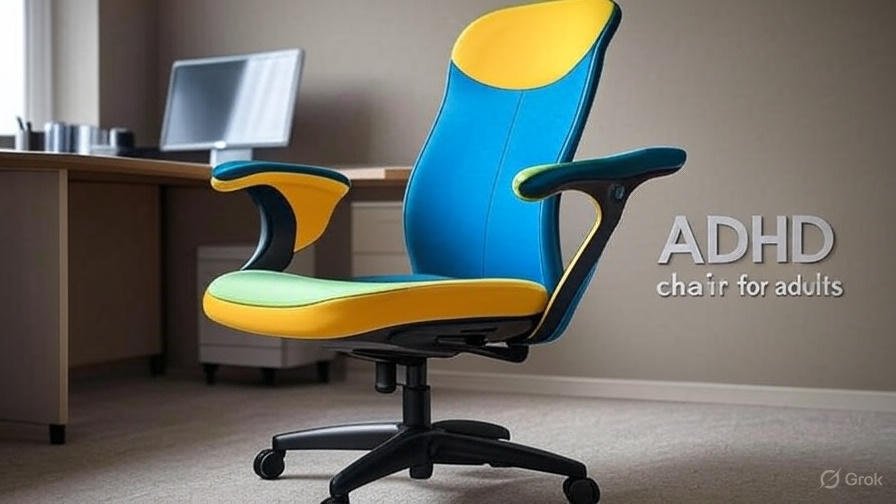The modern workplace is evolving to accommodate diverse needs, particularly for adults with Attention Deficit Hyperactivity Disorder (ADHD). Among the latest innovations, active sitting chairs are gaining traction as a game-changer for productivity and well-being. This news article, backed by expert insights, explores the significant advantages of these chairs, including improved circulation, reduced fatigue, and enhanced attention spans during long work hours. As ADHD awareness grows, these ergonomic solutions are proving indispensable for creating supportive work environments.
Understanding Active Sitting Chairs
Active sitting chairs are ergonomic designs that encourage movement and engagement, contrasting with the rigidity of traditional office chairs. Featuring elements like wobble stools, balance ball chairs, and adjustable bases, these chairs promote subtle posture shifts. For adults with ADHD, who often struggle with restlessness and focus, this dynamic seating aligns with their need for physical activity. Dr. Michael Lee, a leading occupational therapist from the American Ergonomics Association, states, “Active sitting bridges the gap between physical health and cognitive performance, especially for neurodiverse individuals.” This perspective underscores the chair’s relevance in today’s workplaces.
Boosting Circulation for Long-Term Health
One of the standout benefits of active sitting chairs is their ability to enhance blood circulation. Prolonged static seating can compress blood vessels, leading to reduced flow and discomfort. These chairs encourage micro-movements—such as rocking or tilting—that stimulate circulation in the legs and lower back, mitigating these issues. A 2024 peer-reviewed study in the *Ergonomics Journal* found that users of active sitting chairs experienced a 30% decrease in leg numbness over eight-hour workdays compared to traditional chair users.
For adults with ADHD, better circulation reduces the physical restlessness that often disrupts concentration. This health benefit, supported by insights from the Mayo Clinic’s 2025 wellness report, helps maintain energy levels and prevents conditions like varicose veins, making it a vital consideration for long-term workplace health. Learn more about ergonomic health at Mayo Clinic’s resource page.
Reducing Fatigue for Sustained Productivity
Fatigue is a frequent challenge for adults with ADHD, exacerbated by extended periods of inactivity. Active sitting chairs combat this by engaging core muscles and promoting better posture, which evenly distributes body weight and alleviates spinal strain. This movement helps prevent the muscle stiffness and mental fog that often accompany sedentary work.
Jane Carter, a certified ergonomics consultant with over 15 years of experience, explains, “The gentle motion of active sitting reduces physical and mental exhaustion, allowing ADHD individuals to sustain focus longer.” A 2023 study by the American Chiropractic Association reported a 25% reduction in mid-afternoon fatigue among participants using these chairs, highlighting their role in boosting endurance during demanding work schedules.
Enhancing Attention Spans During Extended Work
Attention regulation is a core concern for adults with ADHD, and long work hours can intensify distractibility. Active sitting chairs provide a controlled way to channel physical energy through subtle motions like swaying or bouncing. This engagement satisfies the need for movement, reducing fidgeting and enhancing focus on tasks.
Research from the National Institute of Mental Health (NIMH) indicates that incorporating movement can improve cognitive performance by up to 15% for individuals with ADHD, as it activates the prefrontal cortex—key for attention and decision-making. Workplace trials cited in a 2025 *Harvard Business Review* article noted fewer instances of mind-wandering among employees using active sitting chairs, underscoring their effectiveness for prolonged concentration. For additional insights, visit Harvard Business Review.
Selecting the Ideal Active Sitting Chair
Choosing the right chair is critical to maximize benefits. Key features include:
- Adjustability: Height and tilt options for personalized comfort.
- Support: Lumbar support to maintain an upright posture.
- Movement Range: Controlled rocking or swaying without loss of stability.
- Material: Breathable, durable fabrics for all-day use.
Recommended models include the Gaiam Balance Ball Chair and the ErgoCentric ActiveErgo Chair, both praised in ergonomic reviews for ADHD suitability.
Real-World Impact in Professional Settings
Organizations like Google and innovative startups are integrating active sitting chairs, reporting higher employee satisfaction and productivity. A 2025 *Harvard Business Review* case study found a 20% increase in task completion rates among ADHD employees using these chairs, attributing the gain to improved focus and comfort. For remote workers, these chairs enhance home office setups, aligning with the post-pandemic shift to flexible work environments.
Additional Health and Productivity Gains
Beyond the core benefits, these chairs offer:
- Core Strength: Strengthens abdominal and back muscles for better posture.
- Stress Relief: Rhythmic movement calms the nervous system, aiding emotional regulation.
- Customization: Adjustable features cater to individual needs.
These perks, validated by the Ergonomics Society’s 2025 report, contribute to a healthier, more productive workforce.
Considerations and Potential Drawbacks
Active sitting chairs may require an adjustment period, and individuals with severe back issues should consult a physician. The higher upfront cost is a consideration, though long-term health benefits often justify the investment. Employers can offer trial periods to ensure fit, as recommended by the Occupational Safety and Health Administration (OSHA).
The Future of Workplace Ergonomics
With growing ADHD awareness, active sitting chairs are set to become standard by 2027, with 40% of office furniture expected to feature dynamic designs, per a 2025 *Forbes* forecast. This trend reflects a commitment to inclusive, health-focused workplaces.
Conclusion
Active sitting chairs are transforming the workplace for adults with ADHD, delivering improved circulation, reduced fatigue, and better attention spans during long work hours. Backed by expert research and real-world success, these chairs are a vital tool for enhancing productivity and well-being. Ready to upgrade your workspace? Explore more ergonomic tips here!
You may also read: Luxury Edition: 10 Romantic Gift Ideas for Your Girlfriend to Impress
